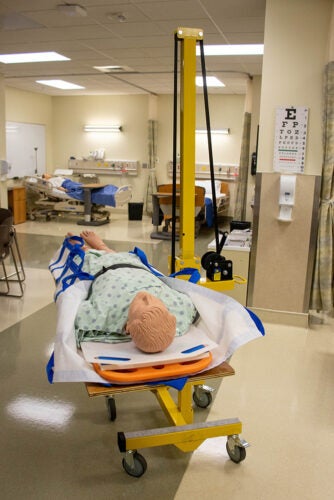Thanks to two engineering students, staff in the College of Health Science Simulation Center now have a new tool to simplify their job.
Manikins are a core part of experiential practice in the center. Various simulation scenarios and practice lab set-ups mean the manikins rarely stay stagnant in one bed. They require regular moving and manipulating for new set-ups, but they aren’t the easiest to transport. Manikins can weigh anywhere between 20-60 pounds, depending on each one’s technical capabilities. Typically, the more complex a manikin’s function, the more it weighs.

It’s not just not weight that makes transportation difficult. The Center’s high-visual fidelity manikins are less heavy, but because they’re made out of silicone, their limbs move more, making them difficult to transport in a practical sense.
“We were looking for a creative solution to our problem of physically moving manikins from beds to storage areas and back again based on what is needed for our various courses,” said Kelley Connor, director of simulation-based research and education at the Simulation Center.

So she pitched their problem to clinical assistant professor Courtney Hollar and the Engineering Plus program.
Hollar curates project ideas for the program which must follow the engineering design process, including the ability for prototyping, testing and analysis. Students develop solutions through this process in their project-based course that provides them “an opportunity to solve real world problems,” said Hollar.
Hollar presented Connor’s manikin problem to her students, and seniors Jack Gignilliat and Bryan Hustrulid tackled the project. They created a lift to make it easier to transport the manikins from their storage place in stacked vertical cupboards into beds in the simulation rooms or practice labs.
Previous best practices required at least two people to move a manikin at a time; now one person can move manikins safely and effectively. The new mechanism minimizes awkward maneuvering and allows staff a simpler way to move manikins safely.
“We are grateful for the opportunity to collaborate with the engineering students,” Connor said. “They were able to utilize an effective design process and we gained a solution to our problem.”